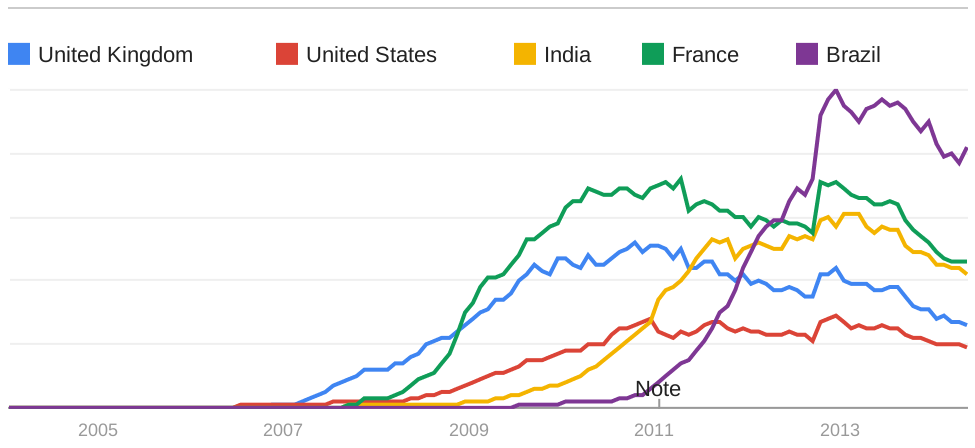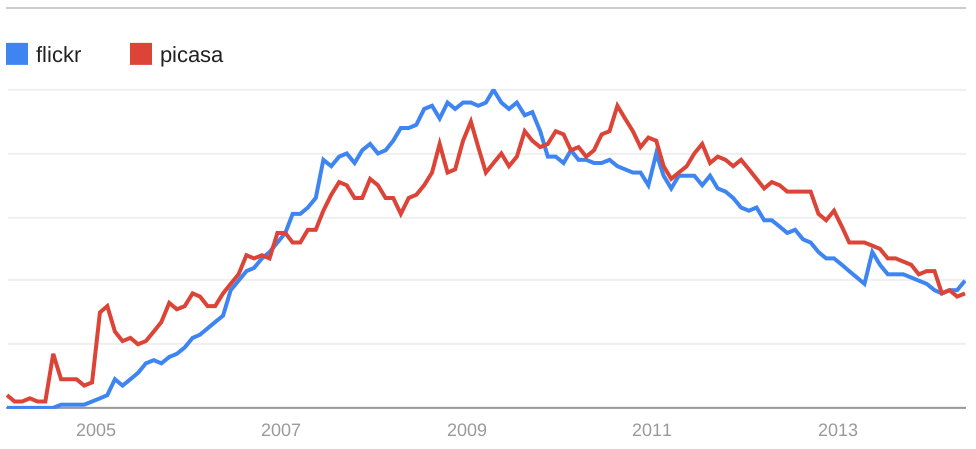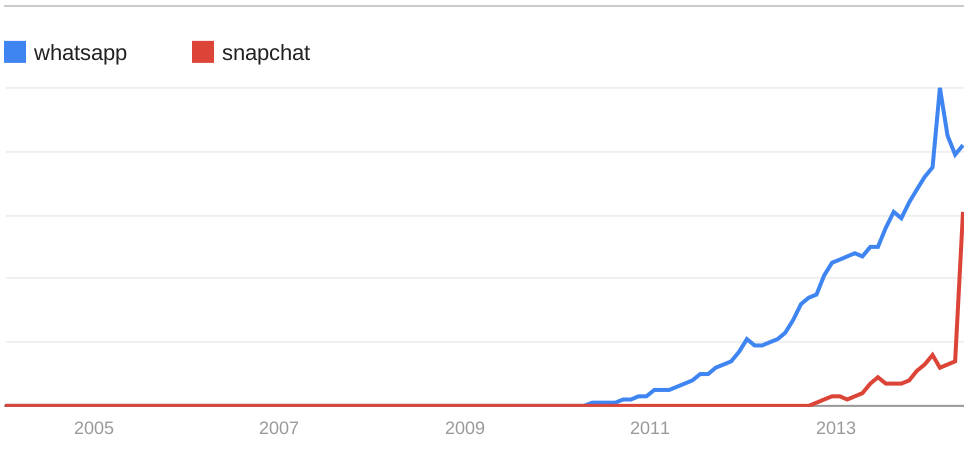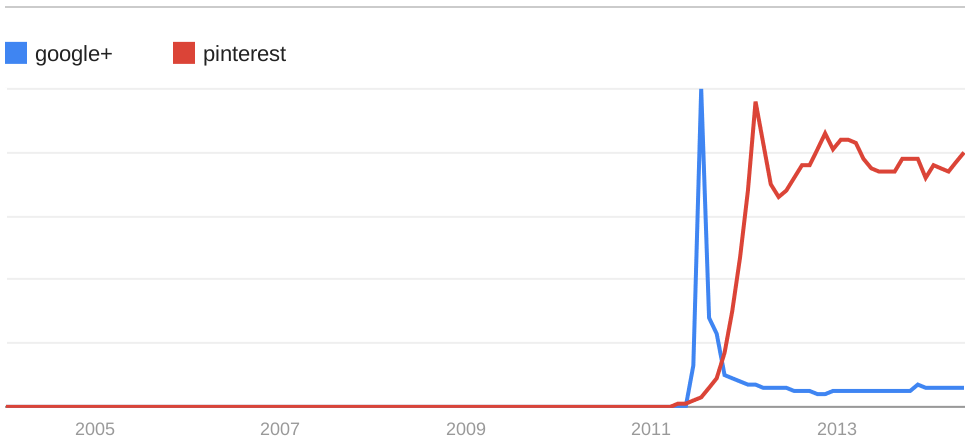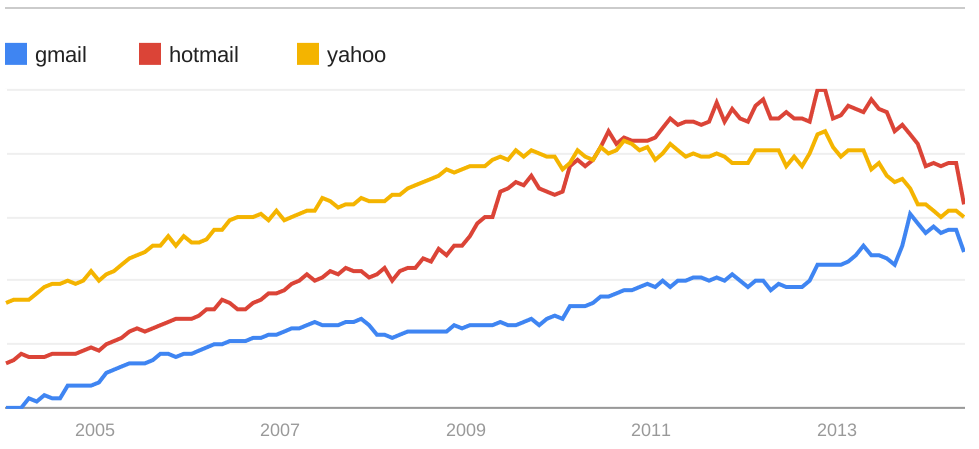Trends: Old social networks are past their peak - What's next?
The doom and gloom of Facebook has become a common story. For example based on of a redesign of the page, or the fact that 14-year-olds wouldn't want to be seen on the same social network as their parents. It's usually speculation, however according to the last link, it is now also admitted in Facebook's own earnings announcement. Furthermore, the search trends on Google also confirm the shift in interest.
Before jumping into these graphs, it is worth pointing out some caveats, even though they should be obvious: First, historical trends are no guarantee of future events. Secondly, the numbers are not absolutes, but capped fractions of Google's keyword distribution. Thirdly, most of the searches will be "navigational", that is typing "facebook" in the URL bar will invoke a Google search, and then immediately take the user to the top result. Therefore, part of the shift in the search trends might be that more people are using native mobile apps where such "navigation search" is not required. Fourthly, these trends are for Google searches, which of course exclude users of search engines like Bing, Yandex, or almost any Chinese user. Finally, statistics lie and cannot always be trusted. You have been warned.
Never the less, there are noticeable changes in the social and communication network landscape. Facebook, Twitter and Flickr seem to have reached a peak and might plateau or decline, while new-comers like Instagram, Reddit, WhatsApp, Snapchat all see steady growth. And then there are the solid stayers who full-fill basic communication needs and services: Gmail, Hotmail, Youtube, etc. They stay, but without much change in their search trends.
Past their peak
The following graphs show the search trends for the terms Facebook, Twitter, and finally Flicker and Picasa compared. (The reason more of the graphs are not compared is that the numbers are often on very different scales. E.g. compare Facebook to Google+, and the later hardly registers as a blip on a flat line a bit over zero). All the sites below show clear decline past their peak point. That peak was some time in 2013 for Facebook and Twitter, while Flickr and Picasa had a peak around 2010 and bumpy decrease in interest ever since.
What's noteworthy about the Facebook graphs is first the significant and sudden increase around the beginning of 2013. It is unclear what caused this, however looking at the country specific graphs it is more present in Brazil than the others. From the Orkut graph below, it drops right down since mid-2012. That was about the same time that network was all but turned off by Google. It could explain some of the increase in searches for Facebook.
Secondly, what's interesting about the country specific Facebook graphs are the relatively flat lines for UK and US, while Brazil and India come later to the party, but show rapid increase. Again, this is probably due to the Orkut effect, since that is where that network was most popular. Beyond that, we should be careful reading too much into that chart, since numbers are not normalized, nor adjusted for population, etc. Still, all trends are clearly down for Facebook in every country.
For the other networks, it is interesting that Twitter seems to follow the same trend as Facebook, albeit at a much lower scale. (Compare the two in the same chart, and they are some two multitudes apart). Although there is not much linking Facebook and Twitter, they do perhaps belong to the same era of sorts. Gaining widespread popularity around the same time in 2009, the same people might have been users of both, and now start to lose interest in both. It will be interesting to see if those comparative trends continue.
Finally, Flickr and Picasa are shown together, both declining over the last four to five years. What's perhaps most interesting here is that they follow each other so closely. So how do people share photos if not on these services? Look no further than the graphs and section below: Instagram and Pinterest are the new Flickr and Picasa.
What does decline look like?
So how does a social network or popular website decline? The following graphs show some large networks through their rise, peak and fall. The common theme in all of them: There is no coming back. Once a trend has faded, it is gone, and the users have moved on. So even if they are not on the list of defunct networks yet, expect no return to greatness. At least in fashion and culture, there is the concept of retro. With ICQ and MySpace, probably not so much. Having said that, the Wikipedia article on ICQ claims there are still 100 million users, but also points out that those are mostly in Russia and Eastern Europe. Google Search might not have such a strong foothold there as in the West, thus that popularity is not reflected in this graph.
The other sites share a similar story: Although MSN is still in use by many, Facebook, Whatsapp, and plenty of built-in chat applications in everything from Gmail to World of Warcraft have taken its place in instant messaging. Orkut has more or less been merged with Google+, and I'm actually not sure if you are able to log in to what once was the Orkut specific site.
Digg lingers on, with a few attempts to stay relevant, but most users have moved on to other forums. Mostly to Reddit, it seems, from the discussion there. See the Reddit chart below.
Finally, nobody would want to be seen on MySpace anymore. Once the hip place for up-and-coming artists, it is now a has-been. Even so, it still claims some 30 million users, and in 2011 was bought by Specific Media Group and Justin Timberlake. It is not clear what they wanted to do with the site, but it might have been cheaper to launch a new service under a new domain. $30 M is after all a bit expensive for the old domain, especially since fewer and fewer searches link there.
Who wins? Who stays?
Now for the winners of the Internet based game of musical chairs. Some clear "hockey stick charts" can be seen: WhatsApp, SnapChat, Instagram, and Pinterest have all seen drastic increase in user interest over the last two to three years, all with no or little sign of decline. Furthermore, Reddit see continued growth. Then there are a group of services which continue to linger on, with no spectacular increase in interest, but overall very solid user numbers. These include the common email services Gmail, Hotmail and Yahoo, as well as Youtube for video sharing.
In the first graph below, it is interesting to note the significant down-tick in WhatsApp's graph. According to the news annotations on Google Trends, this was exactly at the point where Facebook's purchase of the company was announced. At the same time, we can see a stark increase in interest for the competing service SnapChat. For $19 billion dollars, Facebook might have bought the most expensive domain name of all time in an attempt to stay on an upwards trend. It will be interesting to watch how these trends develop over the coming year.
Next is the photo sharing site Instagram compared to Reddit, however maybe it would have been more natural to compare it to Pinterest. Either way, Instagram is clearly seeing strong and increasing interest. However, what will happen when it loses its "hipster" early adopter appeal? Many of its initial users seem to have been of the type which live to shun the mainstream. Other photo upload services like Tumblr, and Imgur are also popular. The former is flatting out a bit, while the later is mostly tied to Reddit, and see steady growth.
As for the discussion forum and online community site Reddit, they continue to see consistent growth. They are catering to pretty much anybody who care to make a group on any particular topic, and have shown very little sign of censuring content. It could turn out to be the Usenet or Yahoo groups of this decade.
The next chart compares Google+ to Pinterest, more as a reference point than those two being related in any way. What's interesting to see though, is the extreme marketing power which comes with any new product Google launches. At its announcement in June 2011 everybody wanted to know what it was about, however that interest clearly did not keep up. In that regard it's compelling to compare it to Pinterest, which saw a similar high spike, but managed to keep that momentum going, although with little increased growth.
The penultimate graph shows Youtube, with slow and bumpy growth. The site can handle videos which attract billions of views, so it is clear that there are few or no competitors out there for video sharing at such an enormous scale. However, as a social network and communication tool it is perhaps less successful. Once infamous for the most banal useless and outright hostile user comments on the Internet, they now face user revolt over Google+ integration. If all Youtube provide is infrastructure for large files, which happen to be video, they might be overtaken. If on the other hand, they manage to take the next step into the living room, and replace the TV, they could see growth in years to come.
The final graph compares the three large email providers Gmail, Hotmail, and Yahoo. Although there are some shifts in interest for all of them, it is nowhere the ups and downs seen in the other charts above. These providers will stay around for a long time, since email will continue to be relevant even if young Facebook users might deny it. Email will continue to be used for communication with businesses, registration to almost everything on the Internet, as well as conventional letter communication. Furthermore, both Hotmail and Gmail are gateways into other products from Microsoft and Google. For example, all Windows and Android users are now strongly compelled to sign up for an account with their respective companies. Gmail also contains an alternative to Skype (which is missing from the chart; although their trend is also rather flat) voice and video communication in the form of Hangouts. In other words, these services are not fads, but rather form the backbone of basic Internet based communication. The reason the don't see further growth, is probably because they are coming close to saturating their current markets.
Federated services
What does the future of social networking and communication look like. It would be foolish to try to predict who will come out on top. There are too many factors and too many unknowns. However, it seems safe to bet on a few basic trends, founded on core ways of communicating. These would fall into the following groups:
- Asynchronous letter based communication; e.g. mail, email.
- Live voice and video communication; e.g. phone and video conferencing.
- Informal messaging, both instant and asynchronous; e.g. chat, SMS.
- Networking, self-promotion; e.g. social networks.
My prediction is that all these types of communication will stay and have strong presence in decades to come. It is maybe a boring prediction, since at its core it says that everything will stay the same. However, looking at very broad lines that has been the case for centuries. We tend to get blinded by new shiny technology and fashion, and forget that rounded corner on an iPhone does not change the basic form of communication which is voice over a telephone network.
Another example is letter or asynchronous one-to-one targeted message based communication. That has existed for millennia, with modern postal systems perhaps being one of few the significant changes before email arrived. We tend to take the fact that a letter or postcard can be sent from anywhere to anywhere in the world for granted, just as we take the Internet based electronic mail infrastructure for granted. What is important to highlight with both systems is that they are federated. That is, a message can be sent between different, possibly heterogeneous, countries or email systems / servers, without the users of these systems having to worry about infrastructure implementation. For the postal system, that is thanks to the Universal Postal Union, and for email is because of common APIs, where the SMTP (Simple Mail Transfer Protocol) is at the core. It is important, because this is a property which is missing from many modern web based communication tools.
Old style telephone networks also have this property: You can call from any wired or wireless phone in the world to any other, crossing multiple networks involving many different technologies. That has been the case for more than hundred years. "[S]ince the introduction of the public telephone system in the late 19th century, [it has stayed] mostly unchanged despite the introduction of Touch-Tone dialing, electronic telephone exchanges and fiber-optic communication into the public switched telephone network (PSTN)." (Wikipedia) The notable addition in recent times is video based calling, however that does not change the form and motivation for this kind of communication much. It is still mostly used to bring people closer together, to hear eachother's voice, or see eachother's face. It is instant synchronous and intimate. Which of course is why it is preferred by telemarketers; it is often harder to hang up on a call than to throw away flyers received in the mail box.
Compared to mail and phone, SMS and chat are all relatively new communication forms. Perhaps that is why it is not always clear how to relate to them. For example, is SMS and chat asynchronous or synchronous? From a technical point of view, they are both asynchronous: Both parties can send messages without waiting for the other, and message passing is starting and stopping independently. However, using it that way is typically not acceptable. It would be considered as rude to flood the other party with messages, just as it would be rude to interrupt while talking, or not let the other speak. However, how quickly are you expected to reply to a chat message or SMS? Is it instant, as the IM name suggests, or is it acceptable to linger? For how long? There are no set social protocols or rules here, and different communities will make them up as they go along.
Despite those uncertainties though, two things are clear: Instant messaging in the form of chat, SMS, WhatsApp or other implementations will stay as a separate communication form for the foreseeable future. Secondly, most of these services are currently not federated: That is, you cannot send a MSN message to a WhatsApp or Yahoo Chat user. That seems ripe for change. In fact, there is already a protocol for federated instant messaging: XMPP (Extensible Messaging and Presence Protocol) (aka. Jabber). It still has some way to go before it becomes the preferred way of exchanging chat messages, and there might in fact be other protocols which supersedes it. Regardless, the isolated short-message services we've seen over the last twenty years will be forced to standardize. Only then can they become stable back-bone services like the email providers seen in the chart above. The alternative is fads which come and go, which is what we can see in the graphs for the services of today.
The same is bound to happen for other web based communication as well, including video communication, VoIP (voice over IP), and social networking. Currently, you cannot call a Skype user from a Google Hangouts account. For VoIP, SIP (Session Initiation Protocol) is an important protocol, but there are many more often conflicting standards involved. For video, it gets even more complicated, with a long list of video formats, but few standards, and even fewer open standards which would be a necessity for a truly open federated system. (Email would not have gotten where it is today if the SMTP, POP and IMAP RFCs had been patented and closed).
Finally, something similar might happen for social networking, although that is the furthest out, and might not happen at all if the large "social networks" turn out to be mere promotion platforms and substitutes for self-hosted web sites. The feature that would make most sense to standardize on for social networks is the contacts or friends graph. That way, you could create a graph between users of different services like Facebook and Google+. Your contacts on your phone might also appear in your chat, and your social network, and all platforms would understand the links to other users across networks. Of course, that is exactly what many users might not want, as I touched on at the very beginning of this article. You could have something like the Google+ circles concept, where groups of friends and family can be segregated into different audiences. Is this something the causal user is ready to manage? Or will he just create different account for different purposes? Regardless, there would still be benefit in a federated social graph, as it would not matter where an account lived, and one would not have to chase the latest trend, just as email users stay relatively stable today.
On the other hand, if sites like Facebook and Google+ are mere content hosts similar to blogs and web sites, the contact graph might not be so important. It becomes a publishing platform for people who cannot or will not set up their own host and website. If that is the case, what is more important for the user, is that the content can be exported from one site and imported into another. Less he becomes a tenant or even serf locked to his host. Some services have been good at offering those features. However, it will leave them vulnerable to shifting trends and users moving on. Finally, for users who just use Facebook for the games that are hosted there, no message interchange or federation would be required. It is just a content provider and host which can be swapped out at any time. When Facebook dies, will the next FarmVille simply be hosted on Amazon EC2?
Conclusion
The search popularity of the major web sites and services above show the repeating cycles of culture and trends. Some sites and networks become popular, at the expense of others which fade away. Meanwhile, basic communication forms like letter writing and voice continue to be used in exactly the same way they have for centuries. The underlying technology might change, and modern objects will always seem more shiny and fashionable, but the mode of communication does not change.
The outstanding question is what will happen to the new forms of communication, like instant messaging and networked self-promotion. It seems unlikely they will continue to be hosted on separate technology islands, without any interchange. Instant Messaging might see a standard and federated service providers, like email, in the form of XMPP or other standard protocols.
For social networks and self promotion, there are some functionality to standardize on, like the social graph and contact list. However, as a self-promotion and publication tool, perhaps the standard is already there in the form of the HTML based web itself. If the user information, contacts and relations could be a separate federated service, independent of the web site, Facebook or similar platforms would no longer have such a stronghold. Some attempts at this are already in place: Diaspora, identi.ca, and GNU Social are interesting alternatives. Although, all have a long way to go before they reach mainstream.

